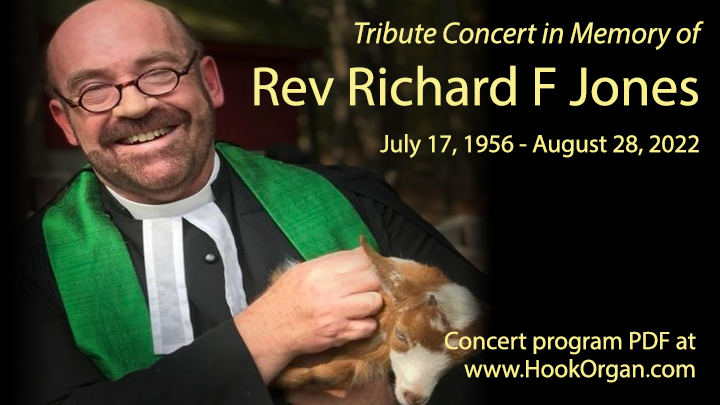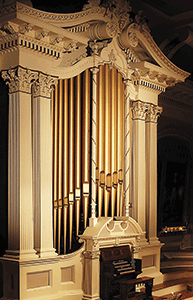The Hook Book, second edition 2024, editor: Will Sherwood, ChM, AAGO, Emeritus Principal Organist
Repository of files: Hook Archives
Mechanics Hall Youtube channel: https://www.youtube.com/c/mechanicshall
Support the 1864 Hook Instrument – “The Worcester Organ” –> Friends of the Hook Organ
2019 SOUND FUSION CONCERT BIOGRAPHIES & PROGRAM ORDER
MECHANICS HALL WORCESTER – HISTORY
Opening our doors in 1857 and, ever since, Mechanics Hall has been a cornerstone of culture and community. Great performance artists, innovators and inventors, authors, orators and scientists, social reformers and next door neighbors all continue to bring the Central Massachusetts community together right here in Mechanics Hall. Our modern mission is to serve the community as a gathering place for experiences that inspire, enrich, and enlighten generations.
Mechanics has been judged the finest pre-Civil War performance hall in the nation. After a storied history of both high and low regard, for the last 40 years Mechanics Hall has built upon its extraordinary past and boldly created a bridge that connects generations with culture and community. It is a rich heritage we all share.
The Hall is a private, not-for-profit organization that is internationally regarded among the world’s great concert halls for its superb acoustics and inspirational beauty. It is also well loved in Central Massachusetts for the important role it has in hosting events. Annually, more than 75 performances and recording sessions, and 200+ business events, galas, and family celebrations take place in the Hall.
BEHIND THE FAÇADE – The Hook Organ a.k.a. “The Worcester Organ”
Elias and George Hook constructed the 52-stop, 3,504-pipe tracker organ in Mechanics Hall in 1864. The organ, called both The Worcester Organ and the Hook Organ, is the oldest unaltered four-keyboard pipe organ in the Western hemisphere located at its installation site. Restored in 1982 and again in 2013, the Worcester Organ is one of the most popular and respected organs in the United States. It has been featured numerous times on National Public Radio, performed in several recordings, and has been featured on television and in a major motion picture, as well as in a music video starring Michael Crawford, the original “Phantom of the Opera.”
The Worcester Organ is used frequently – in wedding ceremonies, graduations, and awards events as well as for the Worcester Organ Concert Series, produced by the Hall in collaboration with the Worcester Chapter, AGO and now in its 11th year!
Sons of a prominent Salem cabinetmaker, Elias and George G. Hook were among a small group of gifted young craftsmen who apprenticed in the 1820s with William M. Goodrich, considered the founder of the organ-building industry in Boston. George built the first organ in 1827 (still extant in Salem’s Peabody-Essex Museum) and Elias built his first soon after. By 1829 they had formed a partnership and were building church and chamber organs, probably in their father’s workshop. In 1832 they moved to a larger workshop in Boston and a year later built their first 3-manual organ. By the 1840s their work could be found in all the New England states as well as New York and Pennsylvania, and by the 1850s in the South and Midwest as well. In 1854 they moved from their original workshop to a large new factory with steam-powered machinery in the Roxbury Crossing area of Boston, allowing an increase in the number of instruments built per year. Although the Hook firm by this time had some worthy competitors, they remained for several decades the leading organ-building firm in the country, from small one-manual organs for country churches to instruments for large churches, concert halls and cathedrals in urban areas. In the 1860s, American organists who had studied in Europe began to request newer tonal directions, and the Hooks complied with the introduction of greater variety in strings, flutes and reeds, while maintaining the high quality of their well-balanced Diapason choruses. Mechanically they were more conservative, relying on well-designed traditional windchests and action components. Francis Hastings joined the firm as an apprentice, but his talents soon raised him to greater responsibility in the firm, and in 1871 the aging Hook brothers made him a full partner under the name of E. & G. G. Hook & Hastings. Under his direction the company flourished, building some important organs in the 1870s, and when the Hook brothers died in 1880 and 1881, Hastings continued to successfully guide the firm into the innovative 1880s and 1890s, showing good business sense by introducing a line of smaller “catalog” organs while still attracting important commissions for large churches and halls. However, strong competition was increasing, and after Hastings’s death in 1916 the Hook & Hastings firm declined, closing its doors in 1936 after building their 2,614th organ. – contributed by Barbara Owen
RESTORATION & MAINTENANCE
Fritz Noack was born in Germany and apprenticed with Rudolf von Beckerath in Hamburg, later working for Klaus Becker, Ahrend & Brunzema, and, after emigrating to the U.S., for Charles Fisk. He founded the Noack Organ Co. in Andover, MA in 1960. His organs can be found throughout the United States, as well as in Iceland and Japan, and one of his earliest large organs was built in 1969 for Trinity Lutheran Church in Worcester. The Mechanics Hall organ was his first major restoration project: it kindled his interest in 19th century American organbuilding, and he has engaged in other restoration projects since. Fritz Noack is a Fellow of the American Institute of Organ Builders and a past President of the International Society of Organ Builders.
The Andover Organ Company was founded in 1955, and in 1961 established a workshop in Methuen, MA. While the firm has built a number of new organs, it also specializes in restoration work, with an impressive number of projects in this field, many involving Hook or Hook & Hastings organs. Their experience in this area, especially under the direction of Robert Newton, proved an invaluable asset during their renovation work on the Mechanics Hall organ in 1988.
Stefan Maier, a native of Germany, received his journeyman certificate there in 1987, working in Oregon and France before settling in Massachusetts as an organ technician and rebuilder skilled in all aspects of organ-related woodworking, metalworking, pipe voicing and design. He now services several organs in Boston and vicinity, and has been responsible for the maintenance and tuning of the Mechanics Hall Hook since 1994.
INTERESTING FACTS ABOUT THE WORCESTER ORGAN
- The tallest pipe is 16 feet tall, and made of Eastern Pine. The largest pipe creates a very low pitch of 32 Hertz.
- In 1864, the cost of the custom-built Hook organ was $8000, equivalent to $5 million today.
- Organs were the most complex large machines invented before the Industrial Revolution. (Clocks were the most complex small machines.)
- At the time, this was the Hook’s largest instrument.
- The Mechanics Hall Hook was built during the Civil War, and the one main shortage was of good old-growth southern pine. Hook’s reserve of this material seems to have gotten them through the period when utilized for important components like windchests and smaller wood pipes, but in this organ, as in its near-twin at Immaculate Conception Church in Boston, there is evidence of the use of inferior northern pine with occasional knots in structural parts and in the very largest pedal pipes. Otherwise their use of wood for Pedal Division pipes and certain manual stops was little different from their normal practice. The use of Belgian zinc, begun around 1850 for front pipes and larger interior pipes, seems also not to have been greatly affected, and the majority of their metal pipework larger than 3’ continued to be made of tin & lead alloy into the 1870s, when higher-content tin spotted metal was sometimes used.
- New to American organs, the Vox Humana (a pipe rank introduced in the U.S. just the year before in Boston’s Music Hall organ) caught the fancy of the press and was accorded much praise for its beauty.
- The swell chamber originally had two horizontal sets of swell shades because organists desired a substantial softening effect when the shutters were closed. Unfortunately the Hooks did not account for the sound-blocking casework – we fear the resulting overall low Swell volume (even at open shutters) was not really intended. The second set of shutters therefore has been (reversibly) removed over the years.
- The Swell was praised in Dwight’s Journal as not only the largest Swell Division outside Europe, but also being easy to play (not to modern standards). While the restorer’s intent was to restore all original aspects of the organ as closely as possible, Noack approved the (reversible) keyboard action modifications made by Andover Organs after the 1982 restoration.
- The original (and current) stop list and voicing still remains valid and useful today because the Hooks at the time had refined a sound that was eminently suited to the use with choirs and audience singing, and was clear, warm, never forced, and was effective in the less-reverberant American churches and halls.
In Memoriam: Rev. Richard Jones, BA, MDiv (1956-2022)
TRIBUTE CONCERT Tuesday April 18, 2023 7pm Mechanics Hall – Free, open seating (donations accepted for Hook Organ)
Performing: Dr. Mark Dwyer, Peter Krasinksi, Alexander Lane, Kristjon Imperio, Maria Ferrante, Will Sherwood.
Works by: Bach, Mendelssohn, Mozart, Faure, Ives, Gade, Brahms, Coleridge-Taylor, Peck, Meyerbeer, Best, and two hymns by Richard Jones.
YouTube Livestream Link: https://youtube.com/live/sOy2124DREk
T&G Article on Richard Jones (by Richard Duckett)

Obituary: https://organweb.com/jones
Youtube Link to service with half hour pre-concert prelude Mechanics Hall, Worcester (Great Hall)

